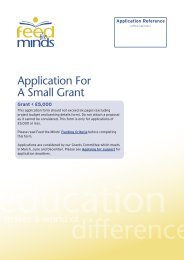Female Genital Mutilation practices in Kenya: - Feed the Minds
Female Genital Mutilation practices in Kenya: - Feed the Minds
Female Genital Mutilation practices in Kenya: - Feed the Minds
Create successful ePaper yourself
Turn your PDF publications into a flip-book with our unique Google optimized e-Paper software.
FGM has been widely recognised as a harmful<br />
practice and was specifically condemned <strong>in</strong><br />
<strong>the</strong> 2003 African Union Protocol to <strong>the</strong> Africa<br />
Charter on Human Rights on <strong>the</strong> Rights of Women 6<br />
(article 5 Elim<strong>in</strong>ation of Harmful Practices), which<br />
states that ‘Parties shall prohibit and condemn<br />
all harmful practice which negatively affect <strong>the</strong><br />
human rights of women and which are contrary to<br />
recognised <strong>in</strong>ternational standards. Parties shall<br />
take all necessary legislative and o<strong>the</strong>r measures<br />
to elim<strong>in</strong>ate such <strong>practices</strong>, <strong>in</strong>clud<strong>in</strong>g.......all<br />
forms of female genital mutilation, scarification,<br />
medicalisation, and para-medicalisation of female<br />
genital mutilation.....<strong>in</strong> order to eradicate <strong>the</strong>m.’<br />
FGm <strong>in</strong> kenyA<br />
PrevAlence And tyPe<br />
Accord<strong>in</strong>g to <strong>the</strong> <strong>Kenya</strong> Demographic and Health<br />
Surveys 7 (KDHS), <strong>the</strong> overall prevalence of FGM is<br />
decreas<strong>in</strong>g <strong>in</strong> <strong>Kenya</strong>. In 2008/9 on average 27%<br />
of female respondents had undergone FGM, a<br />
decl<strong>in</strong>e from 32% <strong>in</strong> 2003 and 38% <strong>in</strong> 1998. The<br />
proportion of women circumcised is higher among<br />
older women, with 15% of women aged 15-19<br />
be<strong>in</strong>g circumcised, as opposed to 49% of those<br />
aged 45-49, fur<strong>the</strong>r <strong>in</strong>dicat<strong>in</strong>g that <strong>the</strong> prevalence<br />
of FGM is decreas<strong>in</strong>g.<br />
The 2008/2009 KDHS found regional variations<br />
<strong>in</strong> prevalence of FGM - 98% of women <strong>in</strong><br />
North Eastern Prov<strong>in</strong>ce had been circumcised,<br />
compared to only 1% of women <strong>in</strong> Western<br />
Prov<strong>in</strong>ce. In Nyanza Prov<strong>in</strong>ce (which <strong>in</strong>cludes<br />
Kuria and Kisii districts), 34% of <strong>the</strong> women were<br />
circumcised, compared to 14% <strong>in</strong> Nairobi, and 10%<br />
<strong>in</strong> Coast Prov<strong>in</strong>ce. Ethnicity is one of <strong>the</strong> strongest<br />
factors <strong>in</strong>fluenc<strong>in</strong>g <strong>the</strong> practice of FGM <strong>in</strong> <strong>Kenya</strong> -<br />
prevalence rates rema<strong>in</strong> highest among <strong>the</strong> Somali<br />
(97%), Kisii (96%), Kuria (96%) and Masai (93%)<br />
ethnic groups and relatively low among <strong>the</strong> Kikuyu,<br />
6 African Commission on Human and People’s Rights website:<br />
http://www.achpr.org/english/_<strong>in</strong>fo/women_en.html<br />
7 WHO <strong>Kenya</strong> Demographic and Health Survey 2008/2009<br />
http://apps.who.<strong>in</strong>t/medic<strong>in</strong>edocs/en/m/abstract/Js17116e/<br />
Kamba and Turkana, whilst among <strong>the</strong> Luo and<br />
Luhya less than 1% of <strong>the</strong> women undergo FGM 8 .<br />
There are also differences <strong>in</strong> <strong>the</strong> prevalence of<br />
FGM between rural and urban areas, with on<br />
average 31% of women <strong>in</strong> <strong>the</strong> rural areas report<strong>in</strong>g<br />
that <strong>the</strong>y were circumcised, compared to just 17%<br />
<strong>in</strong> urban areas. Education is also a significant<br />
factor, with 54% of women without any formal<br />
education be<strong>in</strong>g circumcised, as opposed to 19%<br />
of women who attended secondary school.<br />
In 2008/9, <strong>the</strong> majority of <strong>the</strong> women who reported<br />
hav<strong>in</strong>g been circumcised said that <strong>the</strong>y had some<br />
flesh removed, which usually <strong>in</strong>cludes removal of<br />
<strong>the</strong> clitoris. Thirteen percent had <strong>the</strong> most <strong>in</strong>vasive<br />
form, <strong>in</strong> which <strong>the</strong> labia are removed and sewn<br />
closed (type III). Only 2% percent said <strong>the</strong>y were<br />
nicked with no flesh removed (type IV).<br />
rAtionAle For FGm <strong>in</strong> kenyA<br />
Communities that practice FGM report a variety<br />
of social and religious reasons for cont<strong>in</strong>u<strong>in</strong>g with<br />
it. Deeply rooted customs, l<strong>in</strong>ked to social and<br />
economic benefits, are associated with FGM.<br />
In <strong>the</strong> 2008/2009 KDHS, 24% of women who<br />
were circumcised cited ‘social acceptance’ as<br />
<strong>the</strong> most important reason for circumcision; o<strong>the</strong>r<br />
reasons cited <strong>in</strong>clude ‘to preserve virg<strong>in</strong>ity until<br />
marriage’ (16%); and ‘to have better marriage<br />
prospects’ (9%).<br />
leGAl stAtus oF FGm <strong>in</strong> kenyA<br />
In 1999, <strong>the</strong> M<strong>in</strong>istry of Health issued a National<br />
Plan of Action for <strong>the</strong> Elim<strong>in</strong>ation of FGM (1999-<br />
2019), which set out broad goals, strategies, targets<br />
and <strong>in</strong>dicators 9 . This plan was to be implemented<br />
<strong>in</strong> collaboration with partners. In 2001, <strong>Kenya</strong><br />
adopted <strong>the</strong> Children’s Act which made FGM<br />
illegal for girls under <strong>the</strong> age of 18. The potential<br />
penalties under <strong>Kenya</strong>n law for anyone subject<strong>in</strong>g<br />
a child to FGM is twelve months imprisonment<br />
8 GTZ (2007) <strong>Female</strong> <strong>Genital</strong> <strong>Mutilation</strong> <strong>in</strong> <strong>Kenya</strong>.<br />
www.gtz.de/en/dokumente/en-fgm-countries-kenya.pdf<br />
9 Abusharuf R M (2007) <strong>Female</strong> Circumcision: multicultural<br />
perspectives. Penn Press<br />
ee<br />
9.




